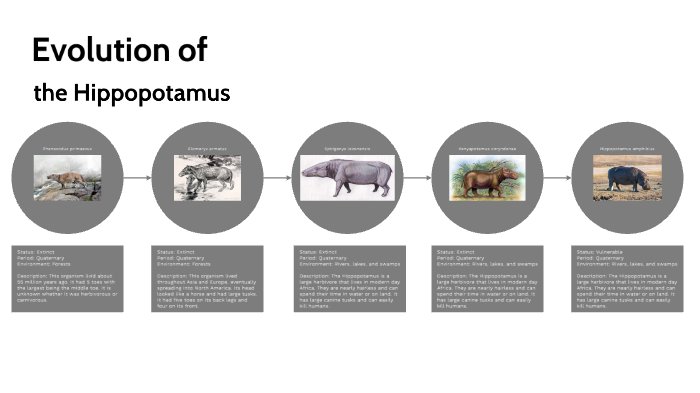
Imagine if animals had family trees like we do. The hippopotamus would have quite the lineage, stretching back millions of years. They are not just big, water-loving mammals; they are part of a larger narrative that connects them to various other species, showcasing the wonders of evolution. But how did these gigantic herbivores come to be? Well, here’s the thing: their journey started long, long ago, when ancestors like them roamed the earth.
The Ancestry of the Hippo
The hippopotamus has a family history that dates back to the Eocene epoch, around 55 million years ago. During this time, the world was a very different place. The ancestors of hippos were small, semi-aquatic creatures that shared traits with modern-day pigs, even sporting tusk-like teeth. These ancestors thrived in a lush, wet environment, and you could say they were the pioneers of the rivers and lakes.
As time went on, these animals adapted to their environments. You might be wondering how exactly they transformed into the hefty hippos we see today. Well, through a process called natural selection, their bodies evolved to be larger and better equipped for life in the water. This transition from land to semi-aquatic living allowed them to exploit a unique niche that few other animals occupied during that time.
One of the most intriguing aspects of hippo evolution is their unexpected relatives. Surprisingly, hippos are closely related to whales and dolphins. Yes, you read that right! They both share a common ancestor that took to the water millions of years ago. So, in a quirky twist of fate, hippos, those massive river dwellers, are part of the same family as some of the ocean’s most graceful creatures.
The Rise of the Hippo
Fast forward a few million years to the Miocene epoch (around 23 to 5 million years ago), and you’ll see hippos starting to take on their modern shape. This period was significant because it marks the time when the hippo’s ancestors began to shift towards the characteristics we recognize today. They became more robust and developed their trademark large heads and wide mouths.
Why the change? Climate shifts led to the drying up of many prehistoric lakes and rivers, pushing these animals to adapt quickly. Their diet evolved, leading hippos to consume more grasses, which is part of why they developed those broad, flat teeth suitable for grinding.
Interestingly, the hippos we know today are part of a group known as Hippopotamidae. There are two primary species: the common hippopotamus and the pygmy hippopotamus. While they share a family tree, the pygmy hippo is much smaller and has a different habitat, emphasizing the diversity that evolution can create even within a single species lineage.
Hippos in Prehistoric Ecosystems
Throughout history, hippos filled a crucial niche within their ecosystems. In prehistoric times, they coexisted with other fascinating megafauna, such as mammoths and giant ground sloths. These interactions shaped their evolution, as they often faced competition for resources. Despite their size and bulk, they were not the apex animals in their habitats.
Hippos played an essential role in maintaining the health of the aquatic ecosystems where they lived. They stirred up sediments in the water and helped nutrient flow, which is vital for maintaining the delicate balance of their environment. This ecological role has persisted through the ages, reminding us that even the largest animals can have a significant effect on their surroundings.
Still, the rise of human civilization brought about serious challenges for hippos. Their habitats began to shrink due to agriculture and urban expansion. Suddenly, these magnificent creatures found themselves competing for space and resources with a rapidly growing human population.
Modern Evolutionary Pressures
Today, the hippopotamus faces many threats fueled by human activity. While they are considered large and powerful animals capable of defending themselves, they need safe habitats to thrive. Here’s where conservation efforts come in. Various organizations are working to protect these creatures and their environments, ensuring that the hippo’s evolutionary story doesn’t come to an abrupt end.
One key aspect of modern evolution is genetic diversity. The more diverse a population is, the better it can adapt to environmental changes. Unfortunately, habitat loss and poaching threaten this diversity, putting additional pressure on the species. Conservationists are researching hippos to understand their genetics better, aiming to preserve this diversity for future generations.
Another fascinating area of study is the behavior of hippos. With their complex social structures and territorial nature, they continue to intrigue researchers. Understanding how their behavior has evolved can offer insights into their adaptability, survival strategies, and the challenges they face in a rapidly changing world.
The Hippo’s Future
So, what lies ahead for the hippopotamus? The answer is still being written. As we gain more insight into their evolutionary history, we become better equipped to protect them. The lessons from evolution remind us that no species is too big or small to be affected by changes in the environment. Efforts to preserve hippos will play a crucial role in maintaining not just the species but the health of entire ecosystems.
You might be wondering what you can do to help. Supporting wildlife conservation efforts, spreading awareness, and educating others about the importance of hippopotamuses can make a difference. Every little contribution counts when it comes to safeguarding these incredible creatures.
In conclusion, the evolutionary history of the hippopotamus is a rich tapestry woven through millions of years. These fascinating animals have traveled a long path from their ancient ancestors to the modern giants we recognize today. Their story is not just about survival; it’s about adaptation, resilience, and the vital role they play in nature. As we continue to learn and appreciate the wonders of evolution, let’s ensure that this chapter in the hippopotamus’s tale doesn’t end anytime soon.
